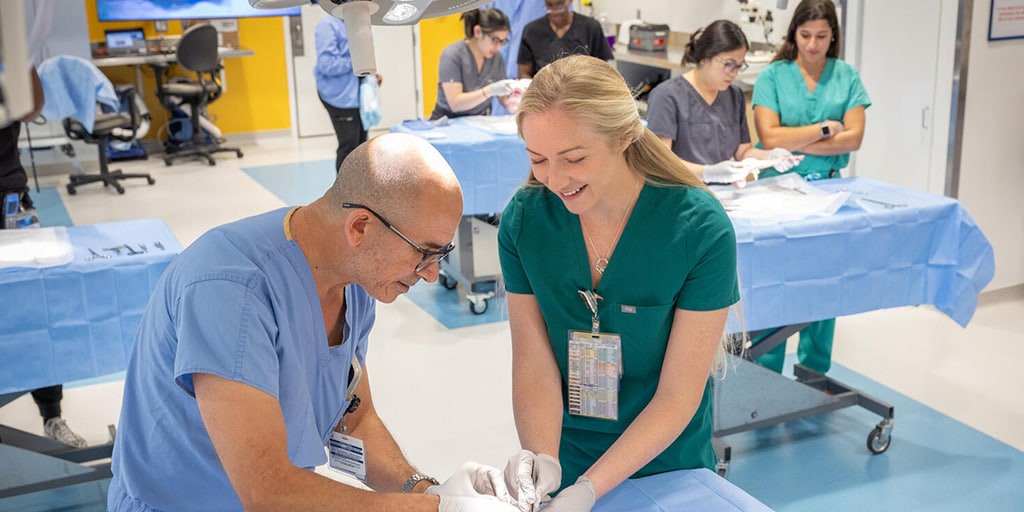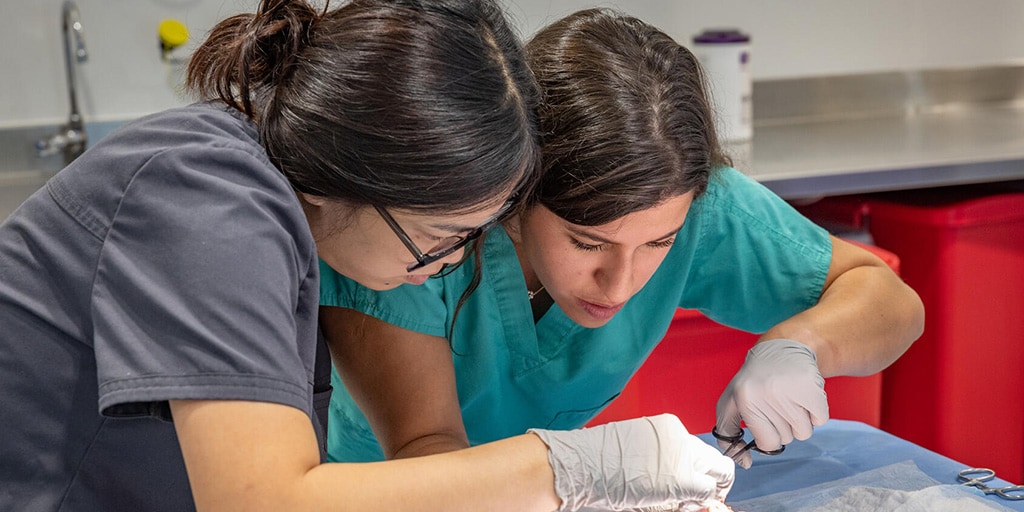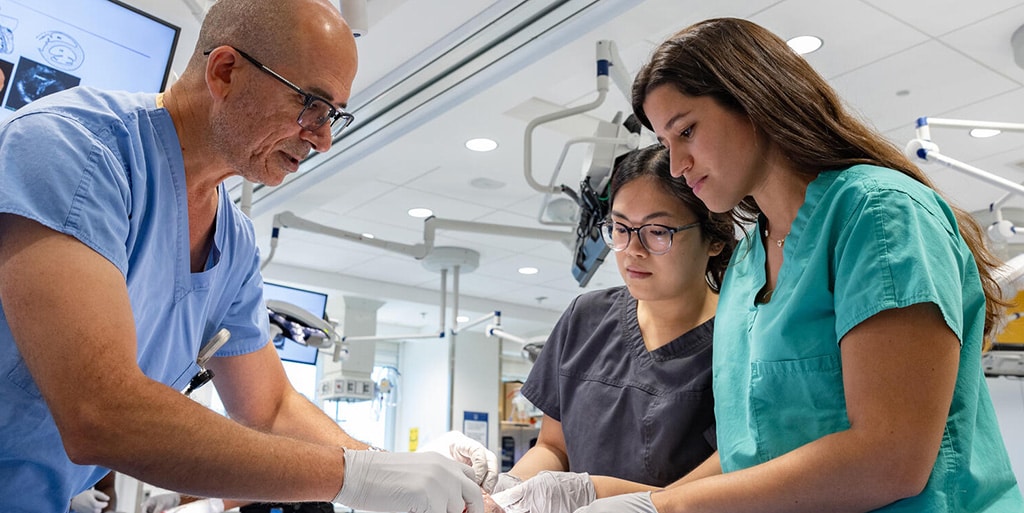Curriculum
/prod01/channel_2/media/mccms/content-assets/academics/residencies-and-fellowships/anesthesiology-residency-arizona/overview/anesth-residency-fl-training-720X480.jpg)
Clinical training
The three clinical anesthesia years (CA-1 through CA-3, otherwise known as PGY-2 through PGY-4) include training in basic, advanced and subspecialty anesthesia, as well as opportunities to participate in research.
Your first and second years of clinical anesthesia training (CA-1 and CA-2) consist of clinical rotations in all basic and subspecialty areas with increasing levels of responsibility as you gain experience.
Rotation schedule
This is a sample curriculum to give you an idea of what you can expect during the Anesthesiology Residency at Mayo Clinic in Jacksonville, Florida.
PGY-1
See the Internal Medicine Preliminary Residency for sample PGY-1 block schedules.
CA-1 year: Basic anesthesia training
| Rotation | Length |
|---|---|
| Basic, general, and regional anesthetic techniques | 8 months |
| Critical care medicine | 1 month |
| Recovery room and acute pain management | 1 month |
| Preoperative evaluation clinic | 1 month |
| Obstetric anesthesia (off-campus) | 1 month |

CA-2 year: Advanced and subspecialty anesthesia training
| Rotation | Length |
|---|---|
| Pain management clinic | 1 month |
| Obstetric anesthesia (off-campus) | 1 month |
| Critical care medicine | 1 month |
| Cardiovascular anesthesia | 2 months |
| Neuroanesthesia | 2 months |
| Regional anesthesia | 1 month |
| Pediatric anesthesia (off-campus) | 2 months |
| Ambulatory anesthesia | 1 month |
| Non-operating room anesthesia | 1 month |

CA-3 year
The first month of your CA-3 year is spent supervising and mentoring the new CA-1 anesthesia residents in the general operating room. CA-3 residents are involved in orientation, basic anesthesia instruction, and supervision of routine anesthesia cases. This opportunity allows CA-3 residents to advance their own skills of teaching, increase their responsibility in the operating room, and prepare themselves for independent practice.
The CA-3 year curriculum consists of rotations in a variety of subspecialty areas. During this training, which is distinctly different from the CA-2 subspecialty experience, you participate in the care of the most seriously ill patients and most challenging procedures in an increasingly independent manner.
Rotations are offered in:
- Cardiovascular and thoracic anesthesia
- General operating room anesthesia, including advanced cases in general surgery, orthopedics, otorhinolaryngology, gynecology, and urology
- Ambulatory anesthesia
- Neuroanesthesia
- Pediatric anesthesia
- Obstetric anesthesia
- Critical care medicine
- Pain management
There are electives in transplant anesthesiology — including liver, kidney, pancreas, heart, and lung — and in transesophageal echocardiography. You may perform up to six months of research (see CA-3 research training below).
You must complete an academic project by the end of your CA-3 year. Academic projects may include special training assignments; Grand Rounds presentations; preparation and publication of review articles, book chapters, manuals for teaching or clinical practice; or similar academic activities. Your adviser oversees the project and ensures that it meets academic standards.
You plan your CA-3 year with help from your adviser based on your interests, needs, and future career goals. Final approval of rotations is made by the program director to ensure all requirements for completion of the Anesthesiology Residency have been met.
CA-3 research training
You may spend six months during your anesthesia training doing clinical or laboratory research or both. The research rotation goals are to provide you with exposure to graduate- and postgraduate-level research while fostering a program that continues research within the Department of Anesthesiology. You contribute to publication-quality research efforts.

Off-campus rotations
During the Anesthesiology Residency, off-campus rotations are arranged at affiliated locations. For elective out-of-state rotations during the CA-3 year, the cost of travel, housing, licensure, and other fees is provided in order to prevent these rotations from becoming a financial hardship.
These rotations include:
- Wolfson's Children's Hospital in Jacksonville, Florida
- University of Florida Health Shands Hospital in Jacksonville, Florida (obstetric and trauma anesthesiology)
- Wake Forest Baptist Medical Center in Winston-Salem, North Carolina (obstetric anesthesiology)
Didactic training
Didactic training is an integral part of the Anesthesiology Residency. You participate in:
- Introductory lecture series
- Core curriculum lectures
- Subspecialty mini-lectures
- Keyword conference
- Journal clubs
- Morbidity and mortality conferences
- Oral board reviews
- Written board reviews
/prod01/channel_2/media/mccms/content-assets/academics/residencies-and-fellowships/anesthesiology-residency-arizona/curriculum/anesth-residency-fl-simulation-1024X5120.jpg)
Research training
Research opportunities at Mayo Clinic are outstanding. You are encouraged to participate with the consulting staff in research projects, which include opportunities for clinical studies and laboratory-based projects.
Board review
CA-1 residents have online access to STARTprep, a one-year curriculum designed to provide them with competency in the anesthesia basic sciences.
Biannual oral board review practice sessions are taught by Mayo faculty who are also current American Board of Anesthesiology oral board examiners.
Call frequency
Mayo Clinic follows the recommendations of the Accreditation Council for Graduate Medical Education regarding call frequency. Call schedules vary by individual rotation, but call is approximately every sixth to eighth night. This allows a day after call with no direct patient care responsibilities and at least one weekend day off each week.
Teaching opportunities
Residents have the opportunity to teach Mayo Clinic Alix School of Medicine students, visiting students, surgery residents, pediatric and internal medicine residents, and other anesthesia residents through operating room instruction and formal didactic lectures.
/prod01/channel_2/media/mccms/content-assets/academics/residencies-and-fellowships/anesthesiology-residency-florida/curriculum/anesthesiology-residency-fl-1024X512-WF2854504_0002.jpg)
Trips and vacation
Learn about the trips and vacation policy.
Moonlighting
Learn about the moonlighting policy.
Evaluation
To ensure you gain proficiency and develop the corresponding technical skills, your performance is monitored throughout the Anesthesiology Residency. You are formally evaluated by your supervising faculty member after each clinical rotation and then meet with the program director to review these evaluations. In addition, you regularly evaluate the faculty to ensure your educational goals are being met.
/prod01/channel_2/media/mccms/content-assets/academics/residencies-and-fellowships/anesthesiology-residency-florida/curriculum/anesthesiology-residency-fl-1024X512-WF2854504_0056.jpg)